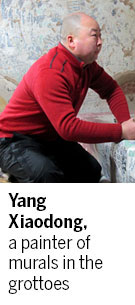Brushing up on history
Updated: 2012-02-23 07:57
By Huang Yuli (China Daily)
|
|||||||||||
TIANSHUI, Gansu - It's still winter and the low season for visitors to the Maijishan Grottoes in Northwest China's Gansu province.

But for Yang Xiaodong, visiting the grottoes has been a daily routine since the early 1990s, even on these snow-covered days.
Yang, a painter from the Maijishan Grottoes Art Research Institute, is dedicated to copying the murals in the grottoes.
It has taken him half an hour to climb the plank road winding along the cliff to Cave No 127 home to more than 100 square meters of murals from the Northern Wei Dynasty (AD 386-557).
They are considered the most precious from the grottoes for their age and artistic value.
One Buddha and two bodhisattva sculptures of four or five meters rise in the middle of the cave, and an A-shape ladder on the right side leads to a narrow attic where Yang works.
"For me, the cave is more like home," Yang said, standing in his makeshift studio consisting of only a wooden table, where the 40-year-old painter lays his brushes, paint boxes and a painting to be finished.
It's the copy of the mural named Nirvana on the opposite wall. On the left wall is the Illustration to the West Paradise, a mural that covers 10 square meters and took Yang one year and a half to copy.
The murals are fading and peeling from the wall after more than 1,400 years. To preserve the precious relics and extend the life of these frescoes as they fade, the institute started copying them in the 1990s.
"Honestly speaking, I felt lost and deserted in the very beginning, being cast away in this lonely place with caves," Yang recalled. And copying murals isn't as easy as it sounds.
Many parts of the murals are broken after hundreds of years, exposing the mud wall and making images hard to distinguish.
"Photography is also a way to keep copies but doesn't apply to the murals of Maijishan Grottoes because they are too mangled. You have to put your face close and investigate very carefully, then you can know what the fresco is exactly and you can draw it," Yang said.
Today's Top News
President Xi confident in recovery from quake
H7N9 update: 104 cases, 21 deaths
Telecom workers restore links
Coal mine blast kills 18 in Jilin
Intl scholarship puts China on the map
More bird flu patients discharged
Gold loses sheen, but still a safe bet
US 'turns blind eye to human rights'
Hot Topics
Lunar probe , China growth forecasts, Emission rules get tougher, China seen through 'colored lens', International board,
Editor's Picks

|

|

|

|

|

|





